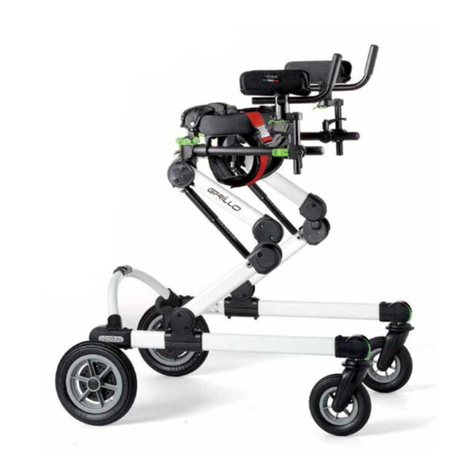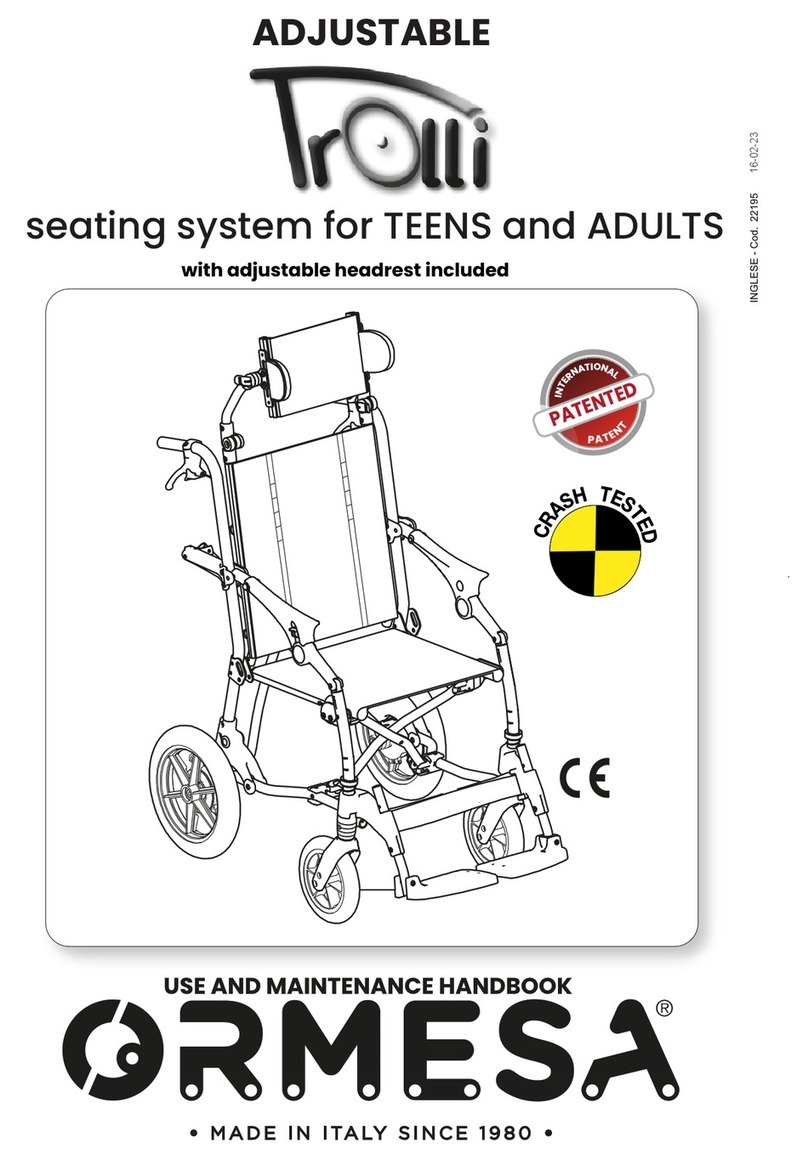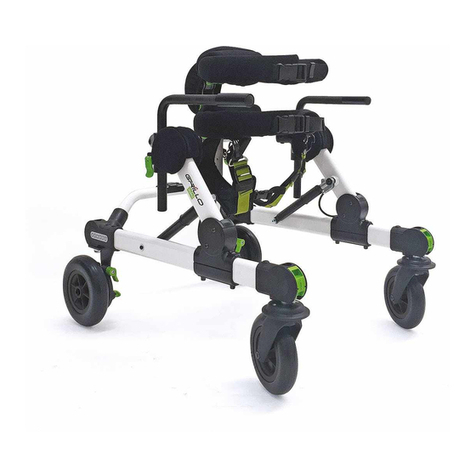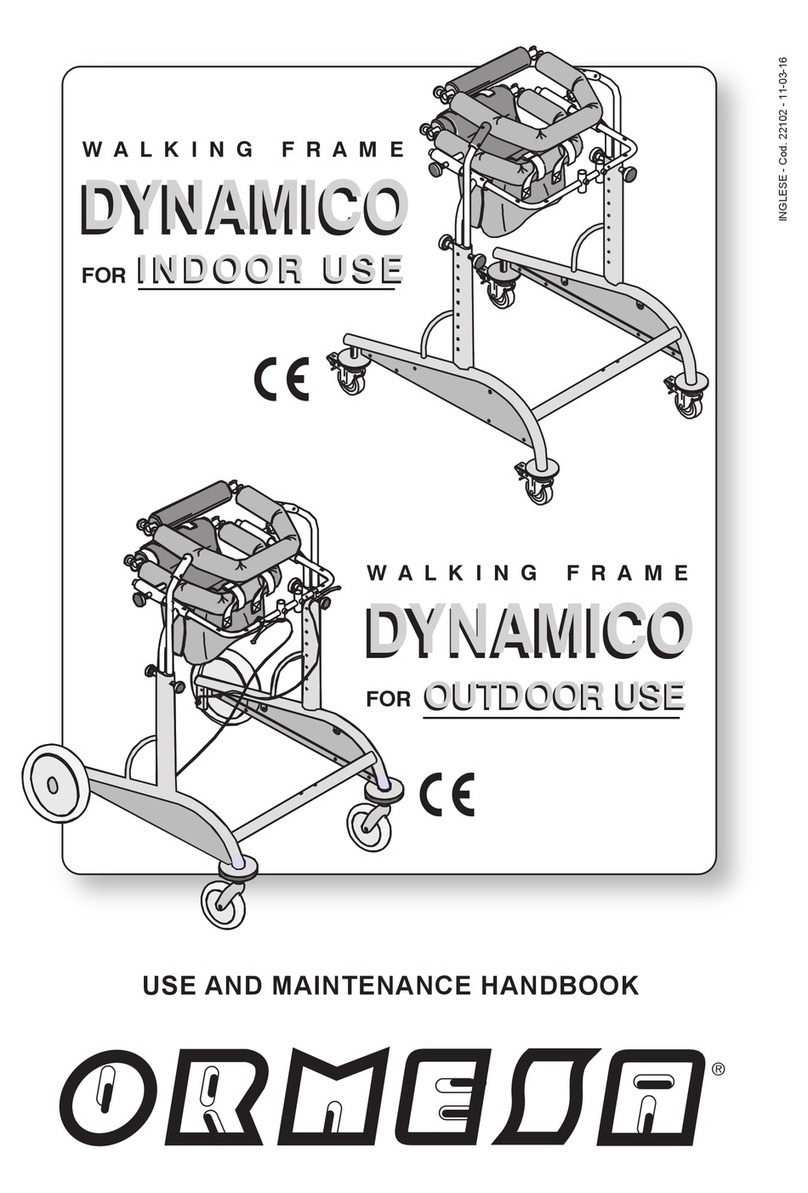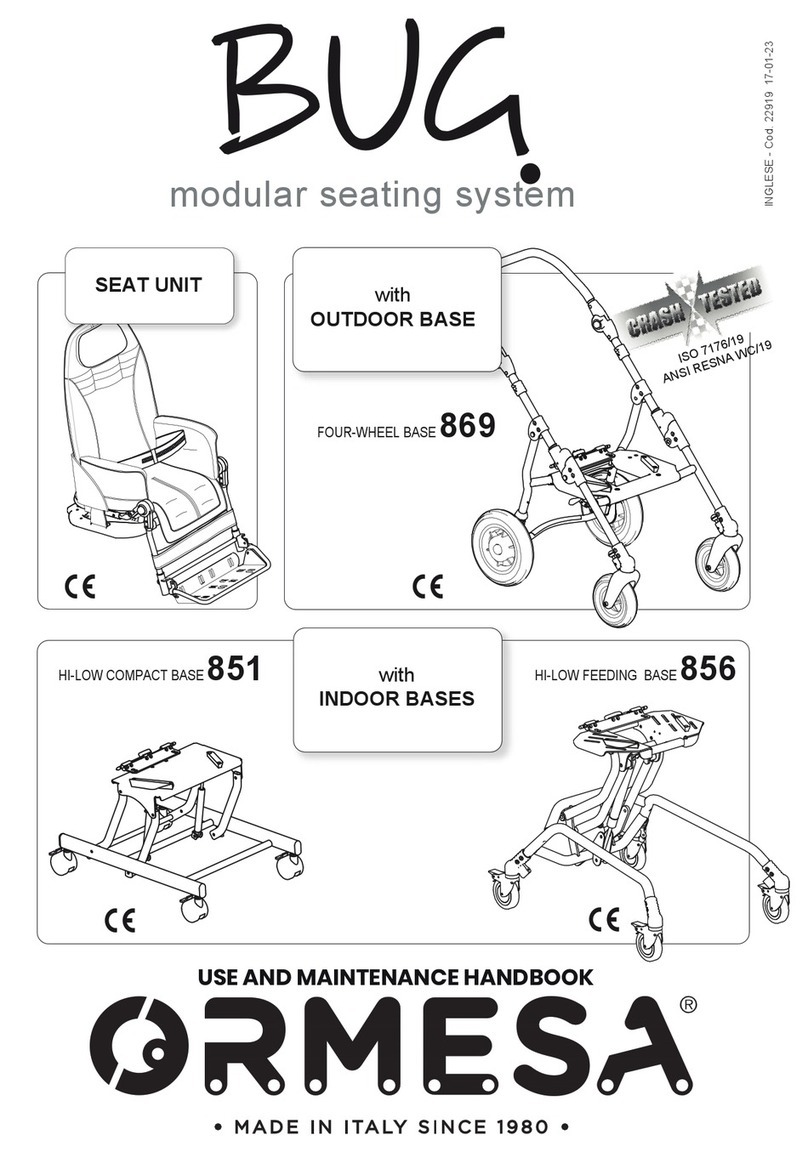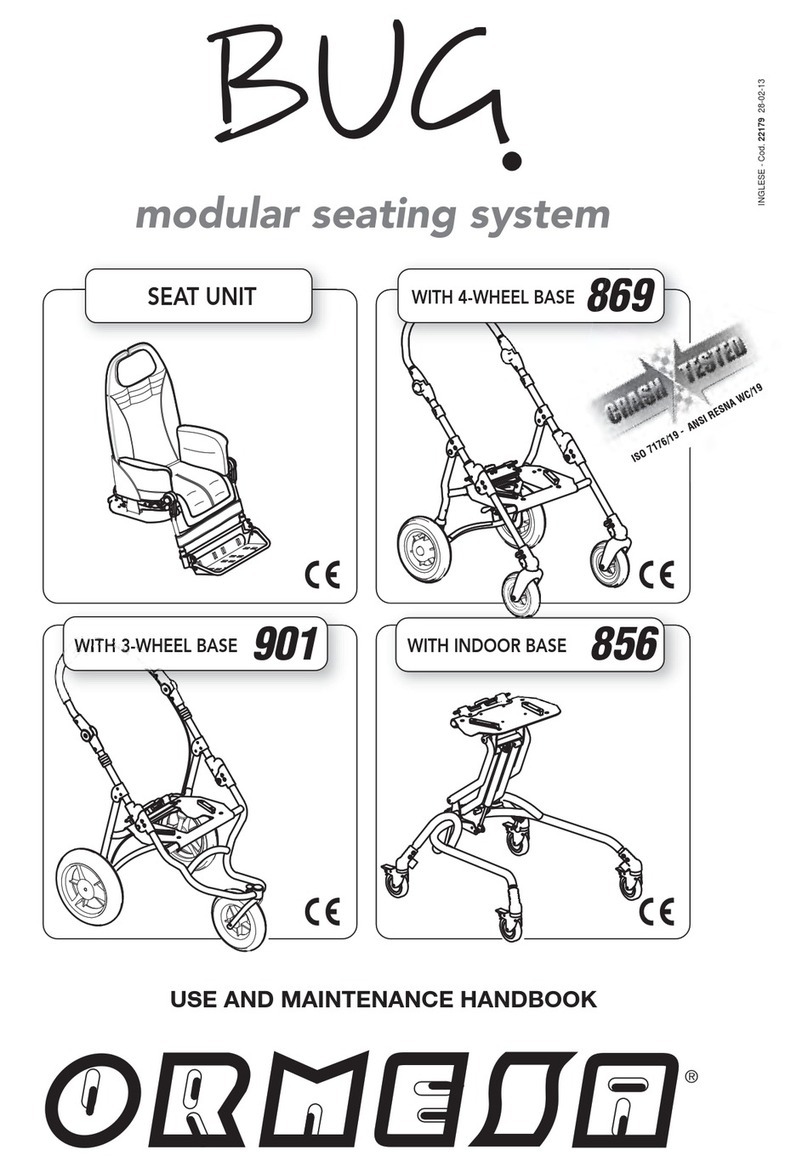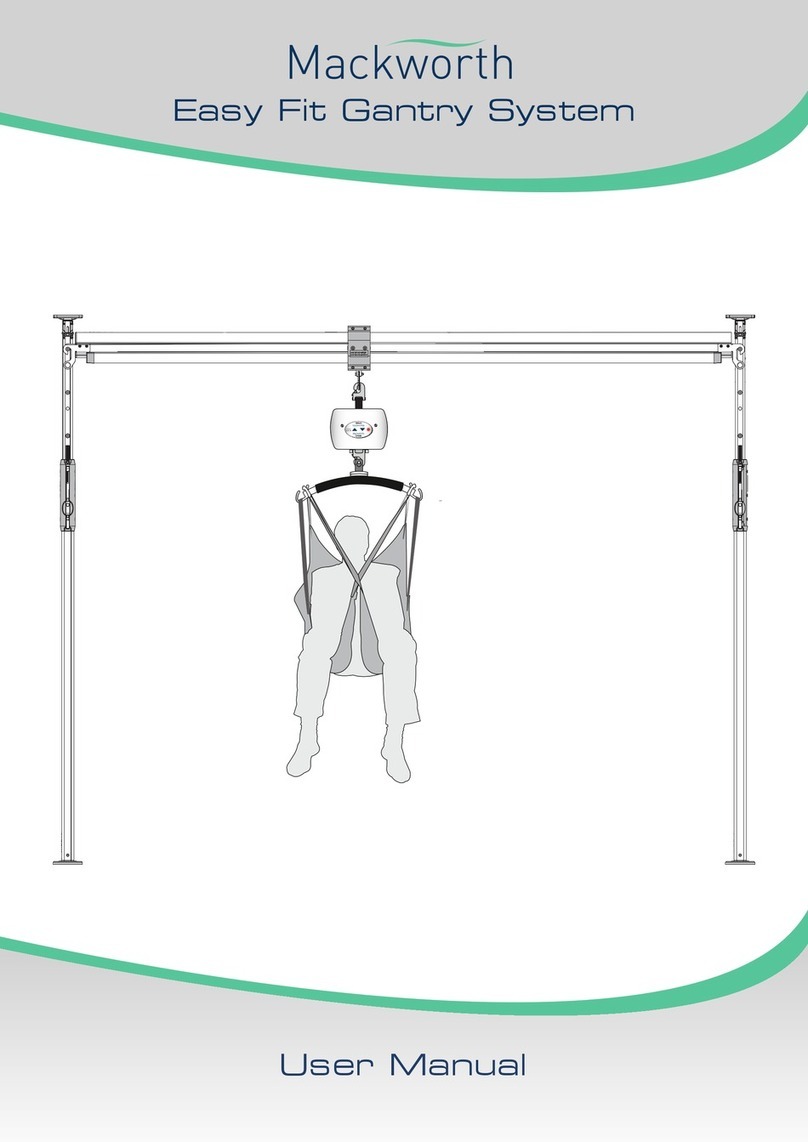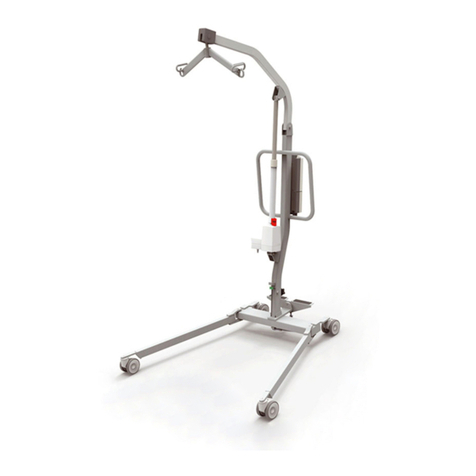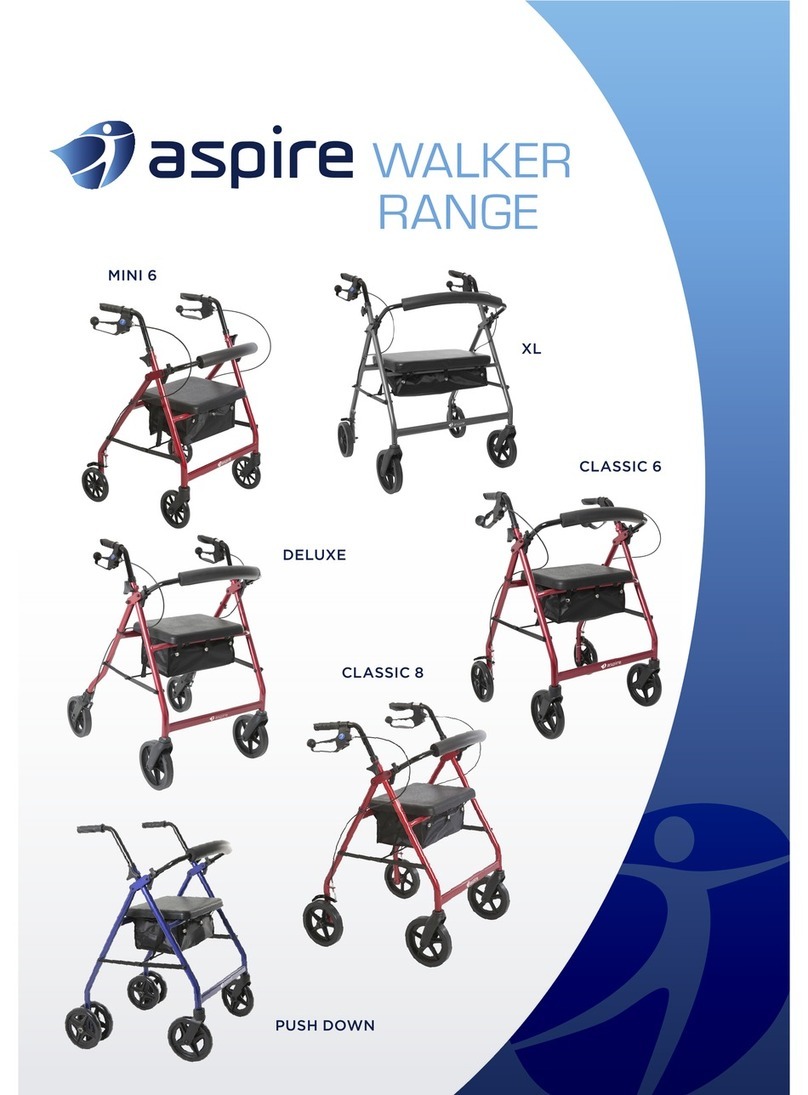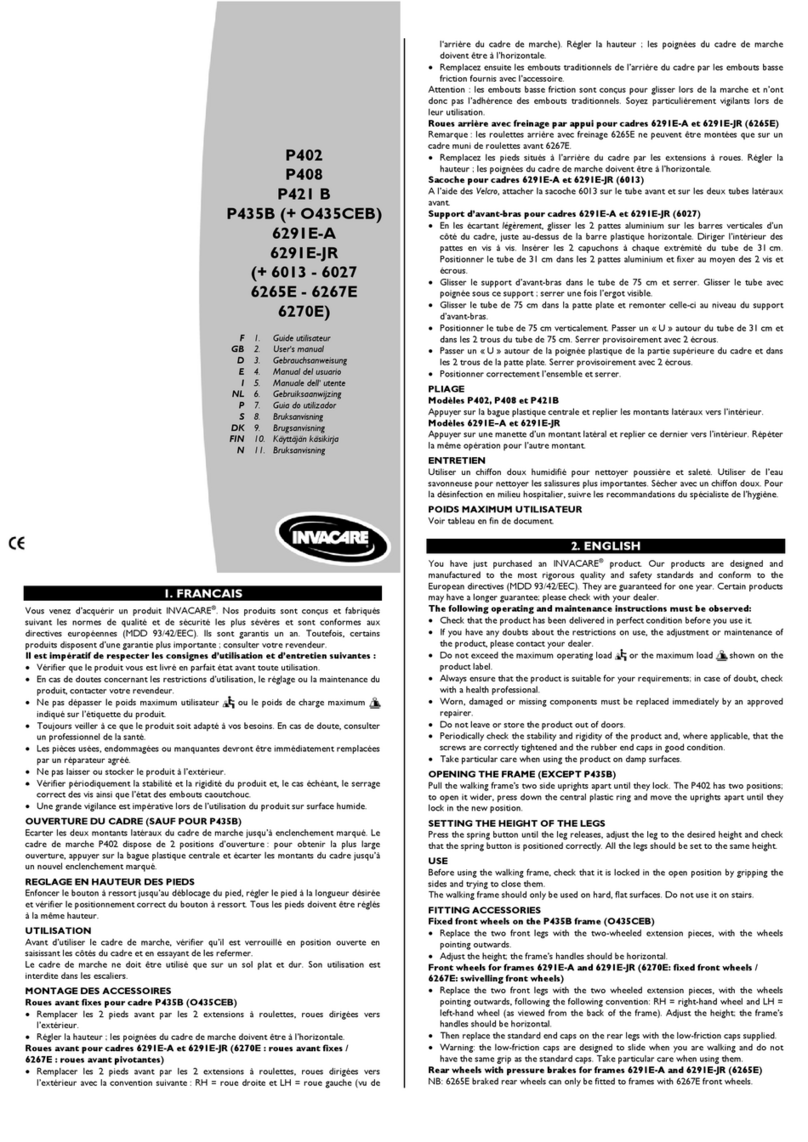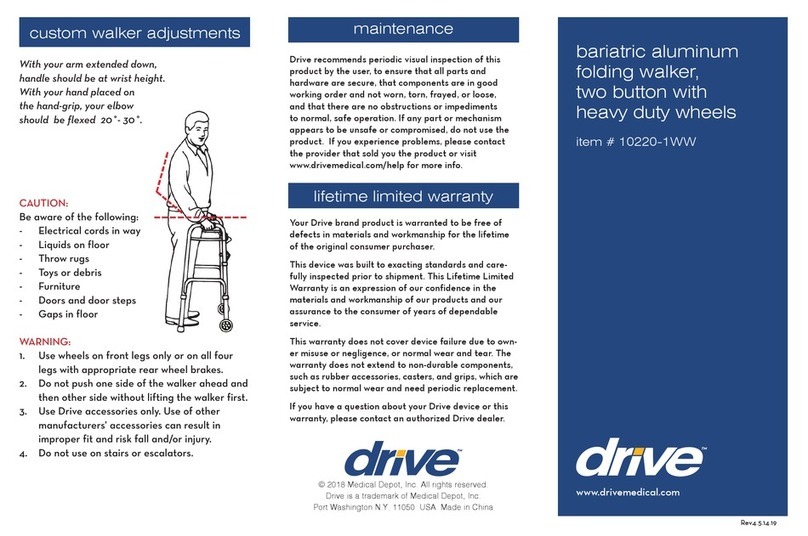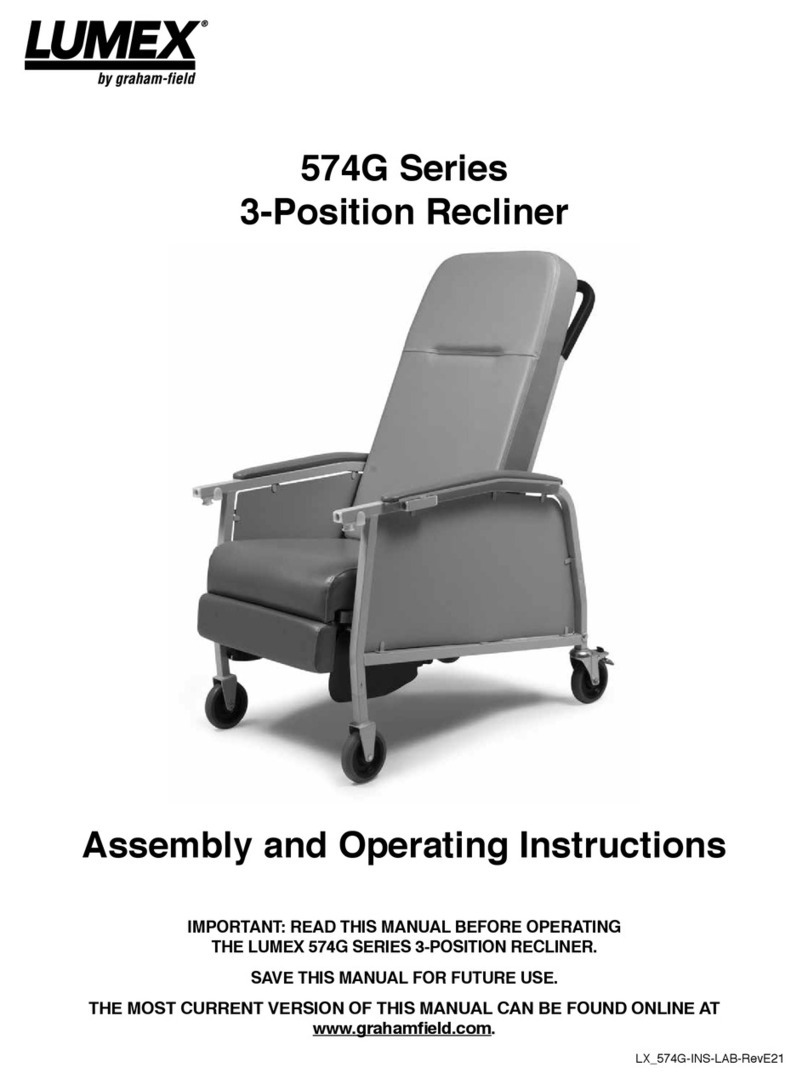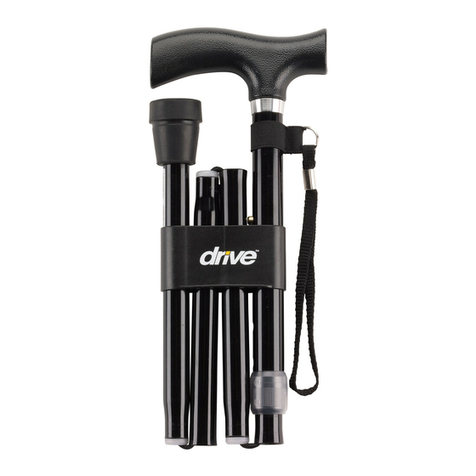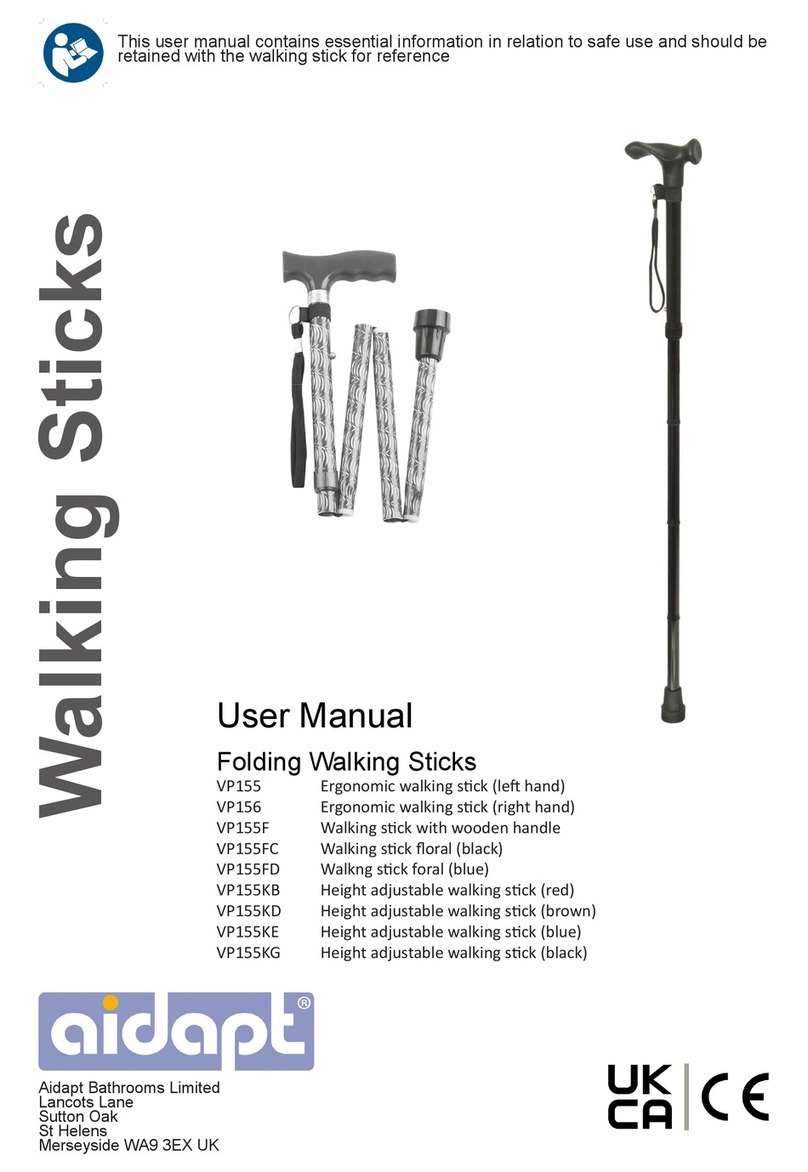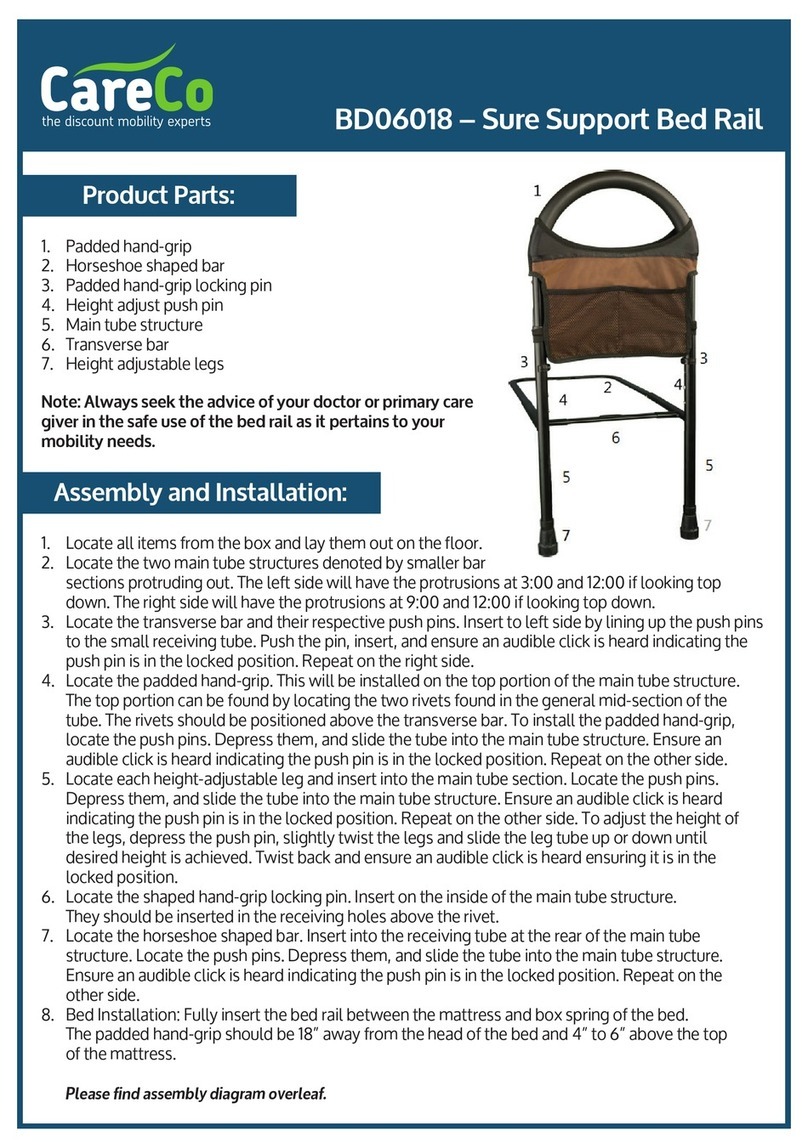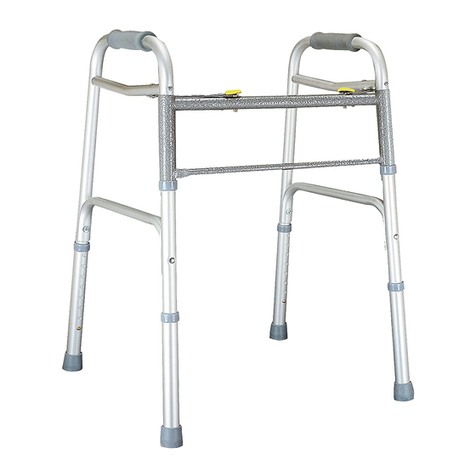Ormesa STANDY 3 Manual

INGLESE - Cod. 22135 - 12/09/2011
STANDY 4
STANDY 3
STANDY 4
STANDY 3
USE AND MAINTENANCE HANDBOOK
STANDING FRAME FOR
THE UPRIGHT POSITION
STANDING FRAME FOR
THE UPRIGHT POSITION


1/33
Thank you for choosing STANDY, from ORMESA s.r.l.
The STANDY combines style and ergonomics without compromising on safety.
ORMESA recommends that you read this manual very carefully to fully understand
its contents. In addition to helping you become familiar with STANDY quickly, it also con-
tains practical tips for making the best use of it safely and keeping it in good working order.
Following the recommendations of this manual will help you achieve the rehabilitative goal
for which this aid was developed.
If, after reading it, you still have questions, contact your retailer, who will be happy to help
you, or call ORMESA directly at +39 0742 22927, send a fax to +39 0742 22637 or send an
Luigi Menichini


2/34
TABLE OF CONTENTS
WARNINGS........................................................................................................................................ 3
GUARANTEE..................................................................................................................................... 4
LABELS AND PLATES ..................................................................................................................... 5
SOME EXAMPLES OF WHAT NOT TO DO WITH STANDY ........................................................... 5
HOW TO MOVE STANDY ........................................................................................................... 6
INITIAL PREPARATION.................................................................................................................... 7
PACKING INFORMATION ........................................................................................................... 7
TECHNICAL CHARACTERISTICS STANDY 3................................................................................. 8
TECHNICAL CHARACTERISTICS STANDY 4................................................................................. 9
HOW TO USE STANDY..................................................................................................................... 10
WHAT DOES STANDY DO ............................................................................................................... 10
HOW STANDY WORKS .................................................................................................................... 11
HOW TO ASSEMBLE STANDY........................................................................................................ 13
Fitting the WORK TABLE and the BACK SUPPORT on STANDY 3 ........................................... 13
Fitting the WORK TRAY and the BACK SUPPORT on STANDY 4 ............................................. 14
HOW TO ADJUST STANDY.............................................................................................................. 15
Adjusting the height of the CHEST SUPPORT on STANDY 3 .................................................... 16
Adjusting the height of the CHEST SUPPORT on STANDY 4 .................................................... 16
Adjusting the height of the HAND SUPPORT RING and BACK SUPPORT on STANDY 3 ........ 17
Adjusting the height of the HAND SUPPORT RING and BACK SUPPORT on STANDY 4 ........ 17
Adjusting the depth of the BACK SUPPORT on STANDY 3 ........................................................ 18
Adjusting the depth of the BACK SUPPORT on STANDY 4 ........................................................ 18
Adjusting the width, height and depth of the KNEEPADS on STANDY 3 and STANDY 4 .......... 19
Adjusting the HEEL STOPS on STANDY 3 and STANDY 4 ........................................................ 20
Adjusting the height of the WORK TABLE on STANDY 3 ........................................................... 21
Adjusting the height of the WORK TRAY on STANDY 4 ............................................................. 21
Adjusting the depth of the WORK TABLE on STANDY 3 ............................................................ 22
Adjusting the depth of the WORK TRAY on STANDY 4 during use ............................................ 22
Opening the BACK SUPPORT on STANDY 3 ............................................................................. 23
Opening the BACK SUPPORT on STANDY 4 ............................................................................. 23
How to remove the HANDLE on STANDY 4 ................................................................................ 24
MOUNTING AND ADJUSTMENT OF ACCESSORIES .................................................................... 25
SIDE SUPPORT 857 on STANDY 3 ............................................................................................ 25
SIDE SUPPORT 857 on STANDY 4 ............................................................................................ 26
4–WHEEL SET 861 on STANDY 3 .............................................................................................. 27
4-WHEEL SET 861 on STANDY 4 ............................................................................................... 28
HEADREST 865 on STANDY 3 ................................................................................................... 29
HEADREST 865 on STANDY 4 ................................................................................................... 30
FRONT FOOT RESTRAINTS with BELTS 902 on STANDY 3 .................................................... 31
FRONT FOOT RESTRAINTS with BELTS 902 on STANDY 4 .................................................... 32
MAINTENANCE AND CLEANING .................................................................................................... 33
CUSTOMER SERVICE AND SPARE PARTS. REUSE .................................................................... 34

3/34
WARNINGS
- Carefully read and understand the instructions in this manual before using the de-
vice because they have been written with the user's safety in mind and they will help
the carer use the product safely and keep it in good working order. The Use and Mainte-
nance Manual is an integral part of the product and must be carefully preserved for future
reference.
- The manual is intended for technically qualified retailers and for users and their
assistants; it provides instructions for usi ng the pro duct correctly a nd must be sup ple-
mented by adequate knowledge of th e rehabilitation program for which it has been pre-
scribed.
-
The manual reflects the technical state of the product at the time it was sold.
ORMESA reserves the right to make any changes to the product or manual suggested by
experience, technical considerations or regulatory developments without any obligation to
update its previous production and relevant manuals.
- STANDY must be prescribed by a medical specialist who will also supervise its use.
- The product must onl y be used by persons whose bodily measurements and weight
conform to the specificati ons in the paragraph “T ECHNICAL C HARACTERISTICS” on
pages 8 and 9.
- STANDY must be used with the assistance and constant presence of qualified per-
sonnel or a family member.
- ATTENTION! Make sure that all adjustable parts have been locked before each use.
- T o make adjustments while the product is in use, follow the instructions in section
“HOW TO ADJUST STANDY” on pages 15 and following of the manual.
- ATTENTION! The product is not fireproof, so keep ST ANDY far fro m flames, cig a-
rettes or fires.
- Clea n STANDY follo wing th e instructi ons shown in the “ MAINTENANCE” section (s ee
page 33).
PRODUCT REPAIRS OR MODIFICATIONS other than the regular maintenance
shown on pages 33-34 of the manual MUST ONLY BE MADE BY ORMESA S.R.L.
OR AN AUTHORIZED SERVICE CENTRE, OR THE WARRANTY AND MARKING
WILL BE VOIDED
- STANDY IS NOT DESIGNED FOR USE OUTDOORS except on flat, paved surfaces
protected from bad weather
Perform regular maintenance and cleaning following the instructions shown in
the "Maintenance" chapter on pages 33-34 and have the device inspected at the
intervals indicated to verify that it is working properly and in good condition,
such as, for example, the absence of scraped paint or worn brakes, failing the warranty
and marking will lapse

4/34
GUARANTEE
ORMESA warrants the STANY 3/4 standers for 2 years.
In case of problems, contact the retailer where you purchased it.
ORMESA will not be liable for damage in the following cases:
- use by an unsuitable person;
- incorrect assembly of parts or accessories;
- unauthorized modifications or service;
- use of other than original replacement parts and parts subject to wear (upholstery, wheels, etc);
- improper use (such as, transporting objects or loads larger or heavier than those shown in the
instruction manual);
- damage caused by incorrect use and lack of regular maintenance, as shown in the instruction
manual;
- exceptional events;
- failure to follow the instructions in this manual.
THE GUARANTEE DOES NOT COVER WEAR PARTS, which are subject to wear and tear, such
as the upholsteries and the wheels.
HOW TO STORE AND TRANSPORT THE MEDICAL DEVICE
TO AND TRANSPORT THE MEDICAL DEVICE
THE DEVICE MUST BE STORED AND PACKED using the Ormesa original pack-
aging materials, unless the guarantee will be voided
-Once unpacked, THE TRANSPORT OF THE DEVICE must be done by
ANCHORING ADEQUATELY it to the vehicle
-When travelling by plane, or in the car, DO NOT SUBJECT THE FOLDED FRAME
TO LOADS THAT, especially with road bumps, COULD DAMAGE ITS
STRUCTURE
THE DEVICE MUST BE PARKED / STORED IN CLOSED AND DRY PLACES
-THE OPERATING ENVIRONMENT HAS NO PARTICULAR INFLUENCE ON THE
DEVICE UNLESS IT IS USED INCORRECTLY, such as by leaving it parked for a
long time in direct sunlight or exposed to bad weather such as rain, or in
MARINE ENVIRONMENTS, where the salt air could corrode the paint and sliding
parts. IN THIS CASE, WE RECOMMEND CAREFULLY CLEANING AND DRYING
THE FRAME FOLLOWING THE INSTRUCTIONS SHOWN IN THE “MAINTENANCE,
CLEANING AND DISINFECTION” CHAPTER ON PAGES 33-34 AND THE
WARNINGS ON PAGE 33

5/34
LABELS AND PLATES
THE MARK CERTIFIES THAT THE BUG SEAT WITH BASES 856, 869 AND 901
CONFORMS TO THE SAFETY REQUIREMENTS OF THE EUROPEAN UNION AND, IN
PARTICULAR, TO THE 2007/47/EC DIRECTIVE ON “MEDICAL DEVICES”
SOME EXAMPLES OF WHAT NOT TO DO WITH STANDY
-DO NOT USE THE PRODUCT WITH PERSONS LARGER OR SMALLER THAN THE
DIMENSIONS SHOWN ON PAGES 8 and 9. STANDY must be prescribed by a medi-
cal specialist in conformity with the laws and standards in force
-DO NOT PLACE THE STANDER ON A SLOPING SURFACE OR NEAR STAIRS
-Do not lift the stander to move it WHEN THE PERSON IS USING IT
-DO NOT REST EXCESSIVELY HOT CONTAINERS OR OBJECTS ON THE TRAY
SURFACE BECAUSE THEY COULD TIP OVER and because the wood or covering
could be seriously damaged
-DO NOT ALLOW OTHER PEOPLE TO USE THE PRODUCT, NOT EVEN FOR
PLAYING
-NEVER LEAVE THE USER UNATTENDED OR NEAR OPEN FLAME OR STAIRS
-NEVER LEAVE STANDY PARKED FOR A LONG TIME IN DIRECT SUNLIGHT OR
NEAR SOURCES OF HEAT: THIS WILL AVOID OVERHEATING THE DEVICE AND
DISCOLOURING THE UPHOLSTERY
DO NOT USE THE PRODUCT WITH MISSING OR DAMAGED PARTS or the warranty
and mark will be voided DO NOT CARRY THE CHILD OVER ROUGH OR STEEP
SURFACES OR STAIRS
Series number Article number
Max load
Date of
production
Warning! Read the
useand maintenance
handbook before use
Conformity with the
European safety
standards
LOT code
®
s.r.l.
Via A. Da Sangallo, 1 06034 Foligno (PG) ITALY Tel. +39 074222927 Fax +39 074222637
MODEL. PART N°
S N
LOT MAX. KG
!
Name of the model

6/34
HOW TO MOVE STANDY
ATTENTION!
IT CAN TIP OVER IF TILTED MORE THAN 20°
STANDY 3
STANDY 4
fig. A
fig. A

7/34
INITIAL PREPARATION
PACKING INFORMATION
Stander A
cm B
cm
C
cm
VOLUME
m³ WEIGHT
kg
STANDY 3 80 80 84 0.537 33
STANDY 4 85 80 93 0.632 42
ATTENTION!
CUT WITHOUT PRESSING TOO
HARD SO AS NOT TO DAMAGE
THE CONTENTS OF THE BOX
REMOVE STANDY
FROM THE BOX
WITHOUT DRAGGING
REMOVING STANDY FROM THE BOX

8/34
TECHNICAL CHARACTERISTICS STANDY 3
Dimensions in cm and inches
HYPHEN-SEPARATED NUMBERS INDICATE THE
MINIMUM AND MAXIMUM RANGE OF ADJUSTMENT
STANDY 3 Aid weight 28.9 kg ( 63.7 Lbs.) Max. load 90 kg (198 Lbs. )
- Available in two sizes: STANDY 3 for children and STANDY 4 for adults (page 9)
- Frame height-adjustable, painted with non-toxic polyester and epoxy-polyester powder paints
- Ergonomic work table in plastic laminated wood, height-adjustable, removable. Semi-rigid
side protections.
- Kneepads width-, depth- and height-adjustable.
- Padded depth- adjustable back support.
- Padded height- adjustable chest support.
- Heel stops width- and depth-adjustable
- Footrest in aluminium with diamond-pattern, non-skid surface
- Wheels allow moving the aid from one room to another by tilting it, without the user (fig. A on
page 6)

9/34
TECHNICAL CHARACTERISTICS STANDY 4
Dimensions in cm
HYPHEN-SEPARATED NUMBERS INDICATE THE
MINIMUM AND MAXIMUM RANGE OF ADJUSTMENT
STANDY 4 Aid weight 38 kg ( 83.7 Lbs.) Max.load 120 kg ( 264 Lbs.)
- Available in two sizes: STANDY 3 (page 8) for children and STANDY 4 for adults
- Frame height-adjustable, painted with non-toxic polyester and epoxy-polyester powder paints
- Work tray in plastic laminated wood, height-adjustable, removable
- Kneepads width-, depth- and height-adjustable covered with fireproof material
- Arm support adjustable, chromed
- Padded depth- adjustable back support.
- Padded height- adjustable chest support.
- Heel stops width- and depth-adjustable
- Footrest in aluminium with diamond-pattern, non-skid surface
- Wheels allow moving the aid from one room to another by tilting it, without the user (fig. A on
page 6)

10/34
HOW TO USE STANDY
STANDY IS A STANDER DESIGNED FOR ACHIEVING AND MAINTAINING AN ERECT
POSITION.
It is recommended for persons such as paraplegics, quadriplegics, spastics, dystonics, hypoton-
ics and the elderly and MUST BE PRESCRIBED BY A MEDICAL SPECIALIST WHO HAS
DETERMINED:
-that there are no dislocations or fractures of the lower limbs
-that there is no dislocation of the hip
-that there is no bone fragility
-that the person is not convalescing from recent surgery
-that the person's dimensions and weight are not greater than the maximum
weight and/or shorter or taller than the heights indicated on page 6
-the degree of extension of the lower limbs
-that the intended user is capable of using the aid
THE DEVICE IS INTENDED FOR USE:
-at home
-in specialized rehabilitation centres
-in hospital gymnasiums
-in nursing homes
DO NOT LEAVE THE USER UNATTENDED OR NEAR OPEN FLAME OR STAIRS
THE AID MAY BE USED OUTDOORS ONLY IF THE SURFACE IS FLAT AND WELL-
PAVED AND PROTECTED FROM BAD WEATHER
WHAT DOES STANDY DO
STANDY HAS BEEN DESIGNED:
-to provide training in achieving an erect position
-for maintaining the upright position with the load on two feet, which would otherwise be
impossible
With STANDY the user obtains a postural adaptation that allows the body to maintain a secure
position, anchored and bound by the support surfaces, allowing selective exploration and a
dialogue with the surrounding physical/social world.
STANDY can, in fact, be used in normal life situations by children and adults, increasing
opportunities for their active involvement and, thus, real integration.

11/34
AN APPROPRIATE USE OF STANDY CAN FACILITATE:
- the prevention of deformities
- training the postural muscles
- the control and straightening of the head, facilitated by the decreased gravity-opposing ef-
fort of the trunk thanks to the chest support, which can be removed when there is sufficient
trunk control (fig. F, f page 16)
- the programmed control of labyrinthine-vestibular function disturbances
- the experience of manual activities guided by vision, eased by the fact that the upper
limbs are freed from protection and support functions
-
IN ADDITION, AN ERECT POSITION:
- increases respiratory capacity due to increased ventilation and reduced obstructive
phenomena
- facilitates peristalsis
- facilitates circulatory functions
It is especially important to emphasize that STANDY is an aid that increases the ability to
adapt to the surrounding environment by increasing personal autonomy, i.e., the possi-
bility of relating to oneself, others and the physical environment: the ability to “put one-
self in contact with ...”
HOW STANDY WORKS
- Bring the wheelchair close until it touches the base of the stander with its front wheels
ATTENTION
LOCK THE WHEELCHAIR WITH ITS BRAKES
- Position the lower limbs in the HEEL STOPS (see page 20)
- Make sure that the kneepads allow the knees to flex slightly: flexion can be increased or de-
creased with the person in the upright position by adjusting the kneepads or heel stops (see
pages 19, 20)
ATTENTION
If the product has accessory 861, engage the brakes before making the adjustments

12/34
Be very careful to apply ADEQUATE FORCE TO THE CHEST AND PELVIC
SUPPORTS: in fact, it must be SUFFICIENT TO ENSURE A MINIMUM OF STABILITY.
- Fig. B: avoid excessive support that could cause a “feeling of constriction”
- Fig. C: a support that is too “light” could cause “fear of falling” reactions or a feeling
of instability
- Fig. D: in the correct position, the feet should be equidistant from the centre of the sup-
port platform, the pelvis symmetrical and aligned with the trunk, and the trunk and legs
extended
If there is sufficient trunk control, the chest support may be lowered or removed (see p.16).
ATTENTION: THE STANDER MUST ALLOW THE USER TO PERFORM ACTIVITIES
IN A CORRECT AND FACILITATING POSITION AND MUST NOT SERVE TO KEEP THE
PERSON STILL OR IMMOBILE
The work tray, which is also adjustable, should be set so that it allows use of the hands
with the upper limbs semi-extended.
fig. B fig. C fig. D

13/34
HOW TO ASSEMBLE STANDY
fig. e
Fitting the WORK TABLE and the BACK SUPPORT on STANDY 3

14/34
fig. E
Fitting the WORK TRAY and the BACK SUPPORT on STANDY 4

15/34
HOW TO ADJUST STANDY
THE STANDER IS ADJUSTED IN THREE PHASES AND MUST BE PERFORMED UNDER
THE DIRECT SUPERVISION OF THE SPECIALIST WHO PRESCRIBED IT.
1st PHASE: YOU MUST MEASURE:
1. the person's height from below the chest to the ground, which must be used
to position the chest support.
2. the distance from the kneecap to the ground, which must be used to position
the stander's kneepads
The measurements can be taken with the person standing or lying down.
2nd PHASE: INITIAL ADJUSTMENT WITHOUT THE USER
Transfer the measurements made in phase 1 to the stander
3rd PHASE: SUBSEQUENT ADJUSTMENT WITH THE USER
Check:
1. that, once closed, the back support is located in the centre of the buttocks.
The height of the arm support will depend on the positioning of the rear pelvis
thrust cushion
2. the positioning of the kneepads
3. the positioning of the heel stops in width and depth
4. the position of the thoracic support
5. the position of the tray, which must be set by checking the user's height from
under the elbow to the ground (minimum height). In those cases where it is not
possible to take this measurement with the person standing, measure the dis-
tance from bent elbow to feet with the user lying down. To operate the handle
(STANDY 4 only) the tray must be moved away.
6. the vertical alignment of the thorax and the pelvis (any lateral deviation can
be corrected with accessory 857, see pages 25 and 26)
7. the flexion of the limbs: the standing position is determined by the front-to-
back adjustment of the cback support, kneepads and heel stops
ATTENTION:
ALL ADJUSTABLE ELEMENTS MUST BE LOCKED!!!
MAKE SURE THAT ALL THE ADJUSTMENTS ARE SECURELY LOCKED IN PLACE TO
AVOID SITUATIONS OF DANGER FOR THE USER.
WARNINGS:
THE ADJUSTMENTS MUST BE CHECKED BY THE PRESCRIBER AND REHABILITATION
THERAPIST WHEN CONSIDERED APPROPRIATE TO OPTIMIZE THE STANDING
POSITION, BECAUSE ADEQUATE USE AFFECTS THE PERSON'S FLEXION AND
DECREASES HIS/HER RIGIDITY

16/34
fig. F
fig. f
Adjusting the height of the CHEST SUPPORT on STANDY 4
It can be removed for users with sufficient trunk control
Adjusting the height of the CHEST SUPPORT on STANDY 3
It can be removed for users with sufficient trunk control

17/34
height
adjustment
indicator
fig. g
height
adjustment
indicator
fig. G
Adjusting the height of the HAND SUPPORT RING and BACK SUPPORT on
STANDY 3
Adjusting the height of the HAND SUPPORT RING and BACK SUPPORT on
STANDY 4
Other manuals for STANDY 3
1
This manual suits for next models
1
Table of contents
Other Ormesa Mobility Aid manuals
